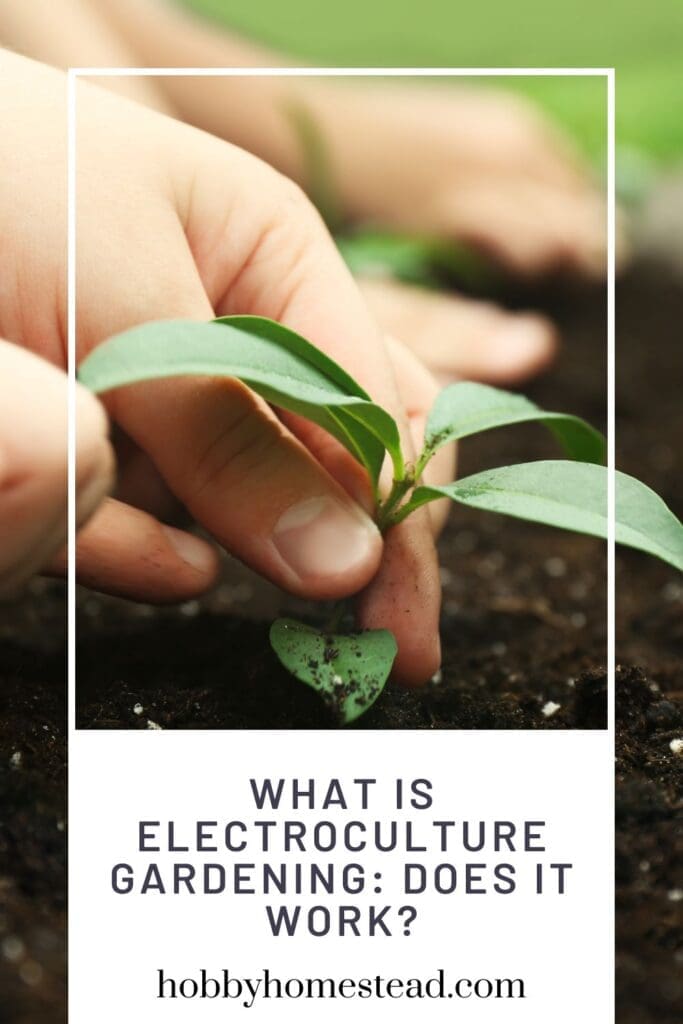Last updated on April 25th, 2025 at 10:22 am
In recent years, gardening enthusiasts and farmers alike have been captivated by the fascinating world of electroculture gardening. It’s a sustainable agriculture method that uses the power of electricity to boost plant growth.
From home gardeners experimenting with their own gardens to larger-scale farmers exploring this innovative method, electroculture gardening has sparked curiosity and debate across social media and Facebook pages.
I first learned about this farming practice on social media. It is something that we want to try this year on our homestead. So, I’m researching this exciting gardening method and hopeful to see some positive results.
There are gardeners who practice electro-culture methods that testify to its powers and ability to produce strong, healthy plants. And reduce damage caused by pests.

But what is it, and does it truly work?
This post dives into the science and practical application of electroculture gardening, exploring its potential to improve crop growth, soil health, and plant development while reducing the use of chemicals.
What Is Electroculture Gardening?
Electroculture is based on the principle that plants, like all living organisms, respond to electric and magnetic energy. By harnessing these natural reactions, gardeners can enhance plant health and stimulate growth.
Electroculture, sometimes called electro-culture gardening, is a method of enhancing plant health and crop yields by using electrical currents, atmospheric electricity, and magnetic energy. By tapping into the earth’s natural magnetism, this organic gardening method stimulates the fertilization of plant life and improves nutrient absorption in the soil.
The idea isn’t new. In the early 20th century, pioneers like Justin Christofleau experimented with atmospheric antennas and copper pyramids to harness earth’s energy for farming. Today, modern tools like copper coils, spiral antennas, and wooden dowels offer home gardeners and professionals alike a way to implement these principles in their vegetable gardens, flower gardens, and more.
How Does Electroculture Work?
Electroculture relies on electrical stimulation to influence plant health and soil health. By introducing negative ions and electrical charges into the soil, gardeners can promote new growth, improve disease resistance, and reduce the need for chemical fertilizers.
Atmospheric energy is captured using simple copper wire or copper rods, which act as conduits for magnetic north and direct this breath of energy into the plants.
This electric field enhances the soil’s ability to absorb nutrients, improving nutrient uptake and resulting in healthier plants.
Gardeners have reported remarkable results, including higher yields and noticeable differences in plant vitality.
Why has electroculture gardening captured so much interest?
The growing enthusiasm for home gardening, homesteading, and producing pesticide-free, chemical-free food plays a significant role. Additionally, many people seek to avoid the unpredictability of grocery store prices by growing their own fresh fruits and vegetables.
Electroculture offers a sustainable solution by reducing reliance on harmful chemicals, benefiting beneficial insects and supporting the health of the broader ecosystem, all while promoting environmentally friendly gardening practices.

Benefits of Electroculture Gardening
Higher Yield and Healthier Plants. Many gardeners have observed amazing results, such as increased crop growth and extended growing seasons.
Reduced Use of Chemicals. By reducing reliance on chemical fertilizers, electroculture supports sustainable agriculture and food security.
Resilience to Climate Change. The technique helps plants withstand excessive heat and shifting weather patterns, making it a valuable tool in the fight against climate change.
Cost-Effective and Eco-Friendly. With basic materials like copper wire and wooden dowels, this gardening practice is accessible and sustainable.
Criticisms and Challenges
Despite its potential, scientific research on electroculture remains limited, and some critics argue that the effects of electricity on plants need further research.
While there’s a wealth of visual evidence shared in garden videos and online communities, skeptics call for more controlled studies to verify claims of new growth and remarkable results.
Getting Started with Electroculture Techniques
Curious about trying this gardening practice in your own garden? Here’s a quick guide to get started.
Create an Electroculture Antenna
It’s surprisingly simple to create a DIY electroculture antenna at home using only a few supplies. There are lots of tutorials online. I have two of them in the reference section.
Whether you choose to create a pyramid or a vertical antenna depends on the types of plants you grow and how much time you are willing to put into creating it.
Gather Materials
Use simple copper wire, wooden dowels, or copper rods to create an atmospheric antenna.
Ensure proper placement to align with magnetic north for optimal results.
Experiment with Small Areas
Start with a vegetable garden or small garden beds to observe noticeable differences.
Document Your Results
Share your experiences with the gardening community to contribute to the growing knowledge of this new idea.
Trial and Error is Part of the Process
Like any new endeavor, learning to apply electroculture in your garden involves a bit of trial and error. For home gardeners, treat electroculture gardening as an experiment. Observe and measure for yourself whether it’s making a difference for your plants.
Don’t hesitate to adjust your approach, such as experimenting with different types of antennas or setups, if your initial attempts don’t seem effective. However, be patient and give each method enough time to work, as plants need time to grow and respond to changes.

Does It Really Work?
The current understanding of electroculture is largely built on anecdotal evidence, personal experiences, and speculative insights. This limited scientific consensus leaves gaps in our knowledge, making it difficult to fully grasp the potential benefits and limitations of electroculture techniques.
Nonetheless, this promising technique offers an exciting avenue for those looking to explore organic gardening methods and achieve healthy plants with minimal effort.
With its potential to improve soil health, reduce reliance on chemicals, and combat climate change, this innovative method may just be the future of farming.
References
Better Homes and Gardens. Electroculture Gardening Uses Earth’s Natural Electric Energy.
Cultivate Elevate. What is Electroculture?
Expedition Homestead. My Electroculture Gardening Setup. High Energy Plant Growth.


